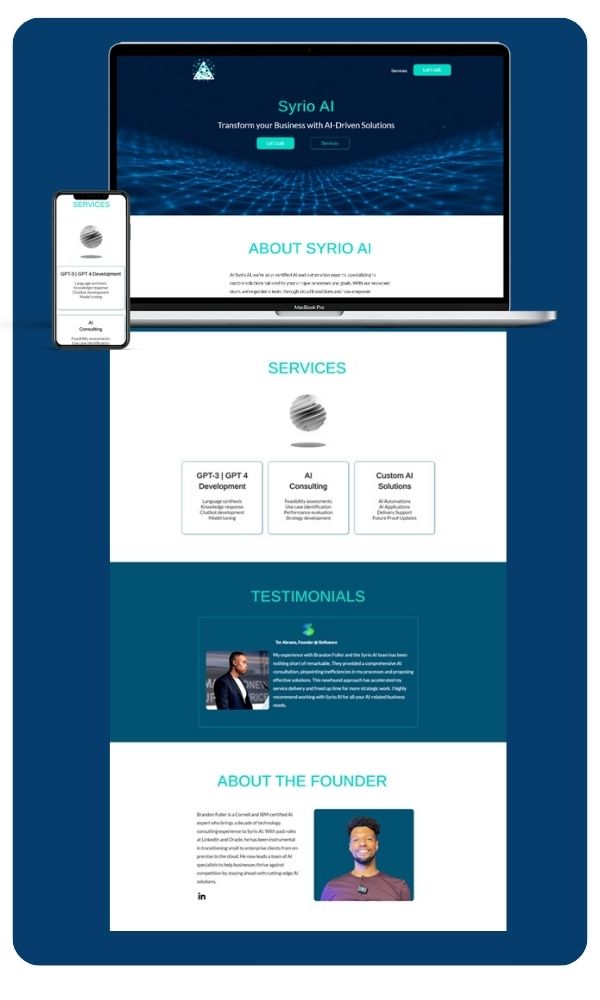A consulting website serves as the digital face of your business. It is a platform where you can showcase your services, expertise, and success stories to potential clients. In a world where the majority of people turn to the internet for information, having an effective online presence is essential for attracting and retaining clients.
A well-designed consulting website not only establishes credibility but also enables you to position yourself as an authority in your niche. By providing valuable content and showcasing your expertise, you can differentiate yourself from the competition and build trust with your target audience.
Table of Contents
- 1. Set up your consulting website for success
- 2. Design a Visually Appealing and Professional consultant Website
- 3. Optimize Your Consulting Website for Search Engines
- 4. Crafting Compelling and Informative Content
- 5. Incorporate Testimonials and Case Studies into your business consultancy website
- 6. Add Effective Call-to-Action Buttons
- 7. Implement Lead Generation Forms and Contact Information
- 8. Mobile Optimization for Consulting Websites
- 9. Integrating Social Media and Blog Content into your consulting website design
- 10. Monitor and Analyze your conulting Website Performance
- Hiring a Professional Website Designer vs. DIY Approach
- Examples of Best Consulting Websites for Inspiration
- Resources for Consulting Website Design and Development
- Conclusion
1. Set up your consulting website for success
When building a consulting website, there are several key elements that you need to consider to ensure its success. These elements include:
Understanding Your Target Audience
Before you start designing your website, it is crucial to understand your target audience. Who are they? What are their pain points? What solutions are they looking for? By answering these questions, you can tailor your website content and design to resonate with your ideal clients.
Choosing the Right Domain Name and Hosting Provider
Your domain name is your website’s address on the internet. It is important to choose a domain name that is easy to remember and reflects your consulting business. Additionally, selecting a reliable hosting provider is essential to ensure that your website is accessible to visitors at all times.
Planning Your Website Structure and Navigation
A well-organized website structure and intuitive navigation are essential for a positive user experience. Before designing your website, create a sitemap to determine the main pages and their hierarchy. This will help visitors easily find the information they are looking for.
2. Design a Visually Appealing and Professional consultant Website
The design of your consulting website plays a crucial role in attracting and engaging visitors. A visually appealing and professional design instills trust and credibility in your potential clients. Here are some best practices for designing your consulting website:
- Use a clean and modern design that aligns with your brand identity.
- Choose a color scheme that reflects professionalism and matches your brand.
- Use high-quality images and graphics to enhance visual appeal.
- Ensure your website is mobile-friendly for users accessing it from smartphones and tablets.
Remember, simplicity is key. A cluttered and complicated design can confuse visitors and drive them away from your website. Here is an example of an AI consulting website we designed at SiteBoost. For more information read our case study on web design for an AI consulting company

3. Optimize Your Consulting Website for Search Engines
Search engine optimization (SEO) is crucial for improving your website’s visibility in search engine results. By optimizing your consulting website, you can attract organic traffic and increase your chances of being found by potential clients. Here are some SEO best practices to consider:
- Conduct keyword research to identify the terms your target audience is searching for.
- Incorporate relevant keywords into your website’s meta tags, headings, and content.
- Ensure your website has a fast loading speed to improve user experience.
- Create high-quality and informative content that provides value to your audience.
- Build high-quality backlinks from reputable websites to increase your website’s authority.
By implementing these SEO strategies, you can improve your website’s rankings and increase your chances of attracting potential clients through organic search.
4. Crafting Compelling and Informative Content
Content is king when it comes to building a successful consulting website. It is through your content that you can showcase your expertise and provide value to your audience. Here are some tips for creating compelling content:
- Identify the pain points of your target audience and address them in your content.
- Use clear and concise language to convey your message effectively.
- Incorporate storytelling techniques to engage your audience and make your content memorable.
- Provide actionable tips and advice that your audience can implement immediately.
- Regularly update your website with fresh and relevant content to keep visitors coming back.
Remember to tailor your content to your target audience and their specific needs. By providing valuable information, you can position yourself as a trusted advisor and attract potential clients to your consulting business.
5. Incorporate Testimonials and Case Studies into your business consultancy website
Testimonials and case studies are powerful tools for building trust and credibility with potential clients. By showcasing the success stories of your past clients, you can demonstrate your expertise and the value you bring to your consulting services. Here are some best practices for incorporating testimonials and case studies into your website:
- Feature testimonials prominently on your homepage or dedicated testimonials page.
- Include client names, job titles, and company names to add authenticity to the testimonials.
- Use before and after case studies to highlight the positive impact of your consulting services.
- Include measurable results and statistics to demonstrate the effectiveness of your solutions.
By sharing real-life examples of how you have helped clients achieve their goals, you can instill confidence in potential clients and increase the likelihood of them choosing your consulting services.
6. Add Effective Call-to-Action Buttons
A well-designed consulting website should include clear and compelling call-to-action (CTA) buttons. These buttons guide visitors to take the desired action, such as scheduling a consultation or downloading a free resource. Here are some tips for creating effective CTAs:
- Use action-oriented language that encourages visitors to take immediate action.
- Make your CTAs visually distinct by using contrasting colors and fonts.
- Place CTAs strategically throughout your website, including on your homepage, service pages, and blog posts.
- Offer a valuable incentive, such as a free consultation or an e-book, to encourage visitors to click on your CTAs.
By strategically placing and designing your CTAs, you can increase the conversion rate of your website and generate more leads for your consulting business.
7. Implement Lead Generation Forms and Contact Information
One of the primary goals of your consulting website is to generate leads and convert visitors into clients. To achieve this, it is essential to implement lead generation forms and prominently display your contact information. Here are some best practices for implementing lead generation forms and contact information:
- Place lead generation forms strategically on your website, such as on your homepage, service pages, and blog posts.
- Keep the forms simple and ask for minimal information to encourage more submissions.
- Offer valuable incentives, such as a free consultation or a downloadable resource, in exchange for contact information.
- Clearly display your contact information, including your phone number and email address, on every page of your website.
By making it easy for visitors to contact you and providing incentives for them to share their contact information, you can generate leads and increase the chances of converting them into clients.
8. Mobile Optimization for Consulting Websites
With the increasing use of smartphones and tablets, it is crucial to ensure that your consulting website is mobile-friendly. A mobile-optimized website adjusts its layout and design to provide a seamless user experience on smaller screens. Here are some best practices for mobile optimization:
- Use responsive web design to automatically adjust your website’s layout based on the user’s device.
- Optimize your images and videos for faster loading on mobile devices.
- Ensure that your website’s fonts are legible and easy to read on smaller screens.
- Simplify your navigation menu for easier browsing on touch devices.
By providing a mobile-friendly experience, you can cater to a larger audience and enhance user satisfaction with your consulting website.
9. Integrating Social Media and Blog Content into your consulting website design
Social media and blogging can play a significant role in driving traffic to your consulting website and engaging with your target audience. By integrating social media buttons and sharing your blog content, you can expand your online presence and build a community around your consulting business. Here are some tips for integrating social media and blog content into your website:
- Include social media buttons on your website to encourage visitors to follow and share your content.
- Regularly share your blog posts and other valuable content on social media platforms.
- Encourage visitors to subscribe to your blog or newsletter to receive updates and valuable insights.
- Respond to comments and engage with your audience on social media platforms.
By leveraging social media and blogging, you can amplify the reach of your consulting website and establish yourself as a thought leader in your industry.
10. Monitor and Analyze your conulting Website Performance
Once your consulting website is live, it is essential to monitor and analyze its performance to identify areas for improvement and track your success. Here are some metrics you should consider tracking:
- Website traffic: Monitor the number of visitors to your website and track the sources of traffic (e.g., organic search, social media, referrals).
- Conversion rate: Measure the percentage of visitors who take the desired action, such as filling out a contact form or downloading a resource.
- Bounce rate: Monitor the percentage of visitors who leave your website after viewing only one page.
- Time on page: Track how long visitors spend on each page of your website.
By analyzing these metrics, you can gain insights into your website’s performance and make data-driven decisions to optimize your consulting website for better results.
Hiring a Professional Website Designer vs. DIY Approach
When it comes to building a consulting website, you have the option to hire a professional website designer or take a do-it-yourself (DIY) approach. Both options have their pros and cons, and the choice ultimately depends on your budget, time, and technical skills.
Hiring a professional website designer can ensure a high-quality and visually appealing website that is tailored to your specific needs. They have the expertise and experience to create a website that reflects your brand and effectively engages your target audience. However, this option can be more expensive and may require ongoing maintenance fees.
On the other hand, taking a DIY approach can be more cost-effective, especially if you have some technical skills and are willing to invest time in learning website design. There are many website builders and templates available that make it easy for beginners to create a professional-looking website. However, this option may require more effort and may not result in the same level of customization and professional polish as a website designed by a professional.
Consider your budget, time constraints, and desired level of customization when deciding whether to hire a professional website designer or take a DIY approach.
Examples of Best Consulting Websites for Inspiration
Looking for inspiration for your consulting website? Here are some examples of best consulting websites that effectively showcase their services and engage their target audience:
- McKinsey & Company: The website of this global management consulting firm features a clean and professional design, with clear navigation and compelling content.
- BCG (Boston Consulting Group): BCG’s website uses a modern and visually appealing design, with interactive elements and engaging case studies.
- Deloitte: Deloitte’s website showcases their expertise through thought leadership articles, videos, and podcasts, providing valuable insights to their target audience.
Take inspiration from these websites, but remember to tailor your design and content to your unique brand and target audience.
Resources for Consulting Website Design and Development
Building a consulting website can be a complex task, but there are resources available to help you along the way. Here are some useful resources for consulting website design and development:
- Website builders: Platforms like WordPress, Wix, and Squarespace offer user-friendly website builders with templates designed specifically for consulting businesses.
- Web design agencies: If you prefer a professional touch, hiring a web design agency specialized in consulting websites can ensure a high-quality and customized result.
- Online tutorials and courses: There are many online tutorials and courses available that can teach you the basics of web design and development.
Remember to research and choose the resources that best suit your needs and budget.
Conclusion
Building a successful consulting website requires careful planning, attention to detail, and a deep understanding of your target audience. By following the best practices outlined in this guide, you can create a consulting website that not only attracts potential clients but also positions you as a trusted authority in your industry. Remember to continually monitor and optimize your website’s performance to ensure its long-term success. So, what are you waiting for? Start building your consulting website today and take your business to new heights.
Ready to showcase your expertise and attract more clients? Contact us today to discuss how we can help you build a professional and effective consulting website.


